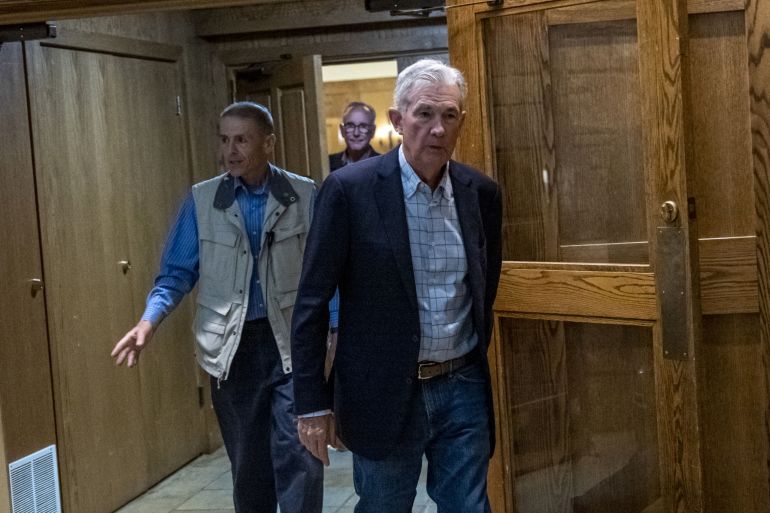Powell says higher US interest rates are likely ‘for some time’
Jerome Powell says the economy is slowing from high 2021 growth rates, and restoring inflation to 2 percent is the top priority.

Federal Reserve Chair Jerome Powell signaled the US central bank is likely to keep raising interest rates and leave them elevated for a while to stamp out inflation, and he pushed back against any idea that the Fed would soon reverse course.
“Restoring price stability will likely require maintaining a restrictive policy stance for some time,” Powell said Friday in remarks prepared for the Kansas City Fed’s annual policy forum in Jackson Hole, Wyoming. “The historical record cautions strongly against prematurely loosening policy.”
Keep reading
list of 4 itemsTens of thousands of UK workers strike as inflation crushes wages
UK inflation jumps to new 40-year high
Turkey’s inflation jumped to 24-year high of 79.6 percent in July
He said restoring inflation to the 2% target is the central bank’s “overarching focus right now” even though consumers and businesses will feel economic pain. He reiterated that another “unusually large” increase in the benchmark lending rate could be appropriate when officials gather next month, though he stopped short of committing to one.
“Our decision at the September meeting will depend on the totality of the incoming data and the evolving outlook,” he said.
Prior to Powell’s speech, investors saw the odds of a half-point or another three-quarter point hike at the Fed’s Sept. 20-21 gathering as roughly even.
“Restoring price stability will take some time and requires using our tools forcefully to bring demand and supply into better balance,” Powell said in remarks that were set to be live-streamed for the first time from inside the lodge where the event has been held since 1982.
Other Fed speakers in recent days have also pushed back against expectations, priced into futures markets, that the Fed would raise rapidly to a restrictive policy stance and then begin to ease.
Restoring price stability will require a “sustained” period of below-trend growth and a weaker labor market, Powell said. “While higher interest rates, slower growth, and softer labor market conditions will bring down inflation, they will also bring some pain to households and businesses,” he said.
Powell’s remarks at the retreat, which gathers top policy makers from around the world, come as US central bankers confront the highest inflation in 40 years. Officials were slow to spot the risk and are now moving aggressively to keep prices from accelerating further. Officials raised rates by 75 basis points at their last two meetings and signaled the same could be on the table again when they gather next month.
Critics have slammed the Fed for failing to anticipate the inflationary surge, which the Fed initially viewed as transitory. Powell told the conference in his address a year ago that price pressures were limited to a relatively narrow group of goods and services. But within months it was spreading and by the time the Fed began raising rates from near zero inflation was already three times their 2% target.
It remains elevated: Inflation according to the Fed’s preferred measure rose 6.3% for the 12-month period ending July, according to a government report released earlier on Friday , while the core measure minus food and energy rose 4.6%. Yields on the U.S. government 2-year note dropped to the lows of the day following the report.
“While the lower inflation readings for July are welcome, a single month’s improvement falls far short of what the committee will need to see before we are confident that inflation is moving down,” the Fed chief told the audience, gathered in person after two years of holding the conference virtually because of the pandemic.
“We are moving our policy stance purposefully to a level that will be sufficiently restrictive to return inflation to 2%.”
Fed officials in June projected rates rising to 3.4% by the end of this year, according to their median estimate, and 3.8% by end 2023. They will update those forecasts in September. Investors were pricing in the probability of cuts in the back half of 2023, though Fed officials are starting to push back against that view.
Looking beyond the current rate-hike cycle, policy makers are trying to assess whether longer-run inflation pressures will remain persistent. Supply chain costs may be shifting higher, and the supply of U.S. labor could remain tight for years to come due to an aging population and limited immigration.
Powell said the labor market is “clearly out of balance” with demand for workers “substantially” exceeding supply.
US unemployment rate matched a five-decade low of 3.5% in July with payrolls fully recovering to pre-pandemic levels.
Ahead of Powell’s speech, several Fed officials emphasized the central bank is in no way done, with Kansas City Fed Chief Esther George noting that the destination of the federal funds rate may be higher than markets are currently priced for.
“We have to get interest rates higher to slow down demand and bring inflation back to our target,” said George, who votes on monetary policy this year.
Financial markets have the benchmark lending rate peaking under 4% early next year.
Asked how high the Fed should push borrowing costs, George said there was “more room to go” and pushed back against bets in financial markets the central bank would begin cutting rates next year.
“I think we will have to hold — it could be over 4%. I don’t think that’s out of the question,” she said in a Bloomberg Television interview. “You won’t know that, I think, until you begin to watch the data signs.”